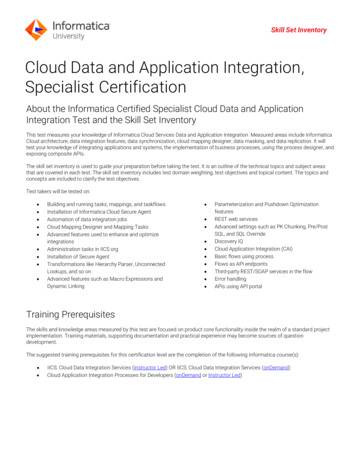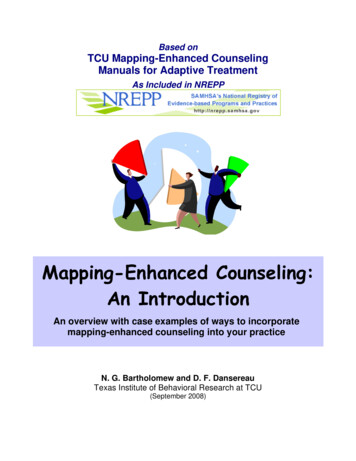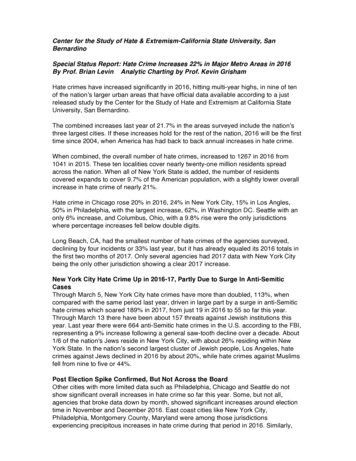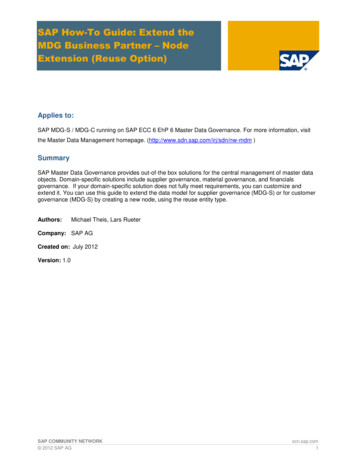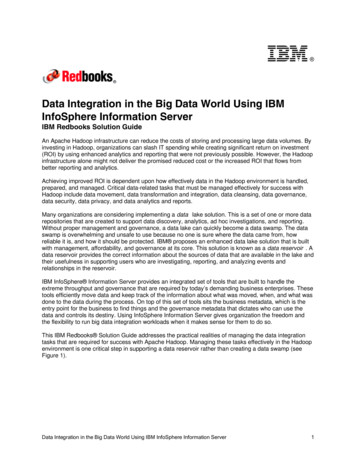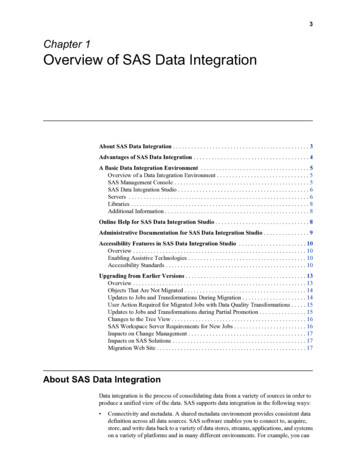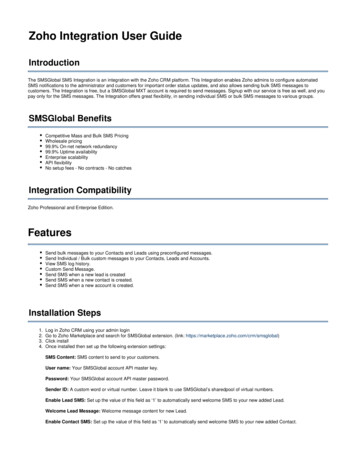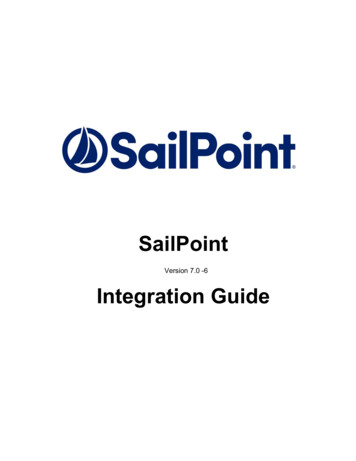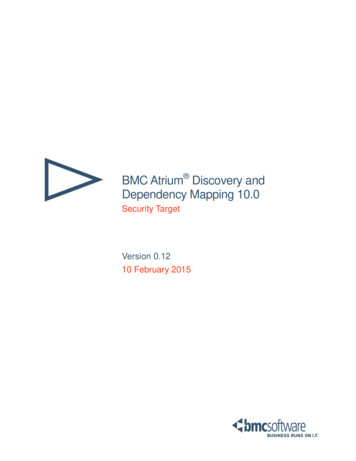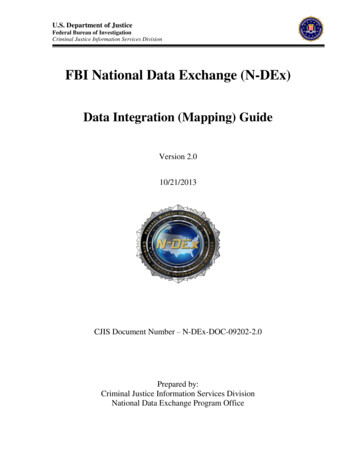
Transcription
U.S. Department of JusticeFederal Bureau of InvestigationCriminal Justice Information Services DivisionFBI National Data Exchange (N-DEx)Data Integration (Mapping) GuideVersion 2.010/21/2013CJIS Document Number – N-DEx-DOC-09202-2.0Prepared by:Criminal Justice Information Services DivisionNational Data Exchange Program Office
CHANGE DESCRIPTION FORMRevisionChange DescriptionCreated/Changed byDateApproved By1.0Initial VersionBrenda Corder9/23/2011Sherri Shreves2.0RevisionJulia Minnocci7/23/2013Sherri Shreves2.0RevisionJulia Minnocci8/23/2013Sherri Shreves2.0RevisionJulia Minnocci10/21/2013Sherri Shreves
National Data Exchange (N-DEx) Program OfficeData Integration (Mapping) Guide1.0Document PurposeThe purpose of this guide is to document the data integration process to N-DEx. Thisprocess includes data mapping, integration development, and initial test datavalidation and verification. This document is intended to supplement guidancethrough the N-DEx Liaison Specialist and serve as a roadmap for submitting data tothe N-DEx system. The intended audience for this document is agency officials andtechnical personnel.2.0ProcessAn N-DEx Liaison Specialist will assist the agency during the integration process.The process is as follows: determining the type(s) of data to be submitted to N-DExand who will complete the work involved (see N-DEx Data Contribution Checklist).Currently, the N-DEx Program Office offers mapping and data integration processassistance for data submission.2.1Data TypesThe N-DEx Information Exchange Package Documentation (IEPD) hasbeen posted to the Justice Standards Clearinghouse located at the left sideof the www.it.ojp.gov web page. The N-DEx IEPDs currently available is asfollows:N-DEx Incarceration/Booking/Probation/Parole 2.1.1 is the N-DExsubmission standard for agencies submitting booking, incarceration,probation and parole, e.g., correctional facilities, prisons, jails, presentenceand pretrial, supervised release and holding reports data.N-DEx Incident-Arrest IEPD 2.1.2 is the N-DEx submission standard foragencies submitting incident, arrest, service call, and missing personreport information. This IEPD also enables N-DEx to provide theNational Incident-Based Reporting System (NIBRS) extract to theUniform Crime Reporting (UCR) Program on behalf of NIBRS certifiedagencies requesting this capability.If a data-item owner wants a NIBRS extract created from their submission,the incident or arrest report must include the NIBRS Originating AgencyIdentifier (ORI) element, the NIBRS Report Category Code element withcorresponding value (indicating what type of submission should beextracted to NIBRS) and an indication of which NIBRS entities toincorporate in the extract (including the Distribution Text element where
the value is ‘NIBRS’ as part of the desired entities). This extract willsatisfy reporting requirements.NIBRS participating agencies, who do not wish to utilize the N-DExextract services for NIBRS reporting, should not provide NIBRS ORI,NIBRS Report Category Code, or Distribution Text elements. Additionaldetails for creating a NIBRS extract will be provided by the N-DExLiaison Specialist.2.2Data Integration DevelopmentThe Data Integration phase is comprised of two major tasks. The first taskis mapping the agency data elements to the N-DEx IEPD. This taskdetermines where each element from the agency data migrates into theN-DEx schema. The second task is the development of the extractionapplication software. This task utilizing the mapping results generates themeans to extract the agency data, wrap it with N-DEx Extensible MarkupLanguage (XML) tags, and write it to an approved readable format ofXML to be digested into N-DEx. The extraction application may bedeveloped using XSLT, JAVA, C , or .NET.It is the agency’s responsibility to assess its capabilities in performingthese tasks. The agency should contact the N-DEx Liaison Specialist todetermine how the N-DEx Program Office can support the agency withdata integration. If the agency chooses to perform the integration, theN-DEx Program Office can offer consultants to answer questions andguide the agency during the mapping/integration development process.Currently, the N-DEx Data Management Team can perform the integrationdevelopment task free of charge upon agency request.2.3Agency Test Data ValidationAfter the agency data has been extracted into the N-DEx IEPD format, thenext step is to conduct XML structural verification checks for NationalInformation Exchange Model (NIEM), Logical Entity eXchangeSpecifications (LEXS), and N-DEx IEPD conformance. This isaccomplished by using the Conformance Testing Assistant (ConTesA).ConTesA is designed to validate an XML instance document against allcurrent versions of the LEXS schema and the N-DEx IEPD. In addition toXML schema validation, ConTesA performs a number of N-DEx businessrule validation checks. The tool provides a style sheet for viewing thedata, which may help to better visualize the LEXS and N-DEx schemasand the way associations work together. ConTesA is available toparticipating agencies in order to expedite the data integration process.It is highly recommended that data be tested and pass the ConTesAvalidation prior to submitting to the N-DEx Program Office for content
verification. The ConTesA conformance tool is located athttps://contesa.ittl.gtri.org/contesa. If a user does not have an account onecan be created. A command line version of ConTesA is also available forlocal execution. A sample of the account creation screen is providedbelow.1. Log in to ConTesA. https://contesa.ittl.gtri.org/contesa/a. Click File Validationb. Enter Username (email address) and Password2. The user will browse agency’s local machine to find the xml instancedocument they wish to validate3. Select ‘Upload’4. After validation has completed, select ‘View’5. The user will click on the arrow next to the view they wish to render,e.g., “LEXS 3.1 Detailed View”6. Click the ‘View’ tab next to the package2.4Test Data File SpecificationFile Names adhere to the following naming convention: AAAAAAAAA YYYYMMDD HHMM NNNN.xml, whereAAAAAAAAA is the Data Submitter Agency ORI,YYYYMMDD is the 4-digit year, 2-digit month, and 2-digit day,HHMM is the 2-digit hour (24-hour clock) and 2-digit minute, andNNNN is a 4-digit sequence number. The date and time in the filename should be the creation date and time of the xml file. Thesequence number is used to guarantee unique file names. Theagency system is responsible for making sure the files are named
uniquely. A sample filename for second file created by a DataSubmitter Agency with ORI ‘ORIPD0001’ at 1:02 pm on March 9,2007, is ‘ORIPD0001 20070309 1302 0002.xml’.File Size:Note: .xml file Xml Document InstanceXML Document sizing recommendations One message package per a single XML Document Instance e.g.WVNDX0000 20080130 1201 0001.xml 70 MB maximum file size for a single XML Document Instance 12 Total attachments inside a single XML Document InstanceZip file sizes for batch ingest: see prerequisite XML Document Instance constraints above Maximum of 20,000 .xml files in a single .zip file. Each XMLDocument Instance (file) would have a single message andpackage 2 GB maximum file size for a single .zip file2.5CJIS Validation & VerificationOnce the agency and/or the N-DEx Program Office has generated errorfree test data through ConTesA, the validation & verification submissiontask may begin.The following are methods to submit test data: External Media device e.g. Compact Disk (CD), Digital VideoDisk (DVD), Hard drive, or other media. The external mediadevice should be sent via Federal Express to the N-DEx ProgramOffice. Electronic submission, including e-mail and Secure File TransferProtocol (SFTP) over the Internet.The below steps describe the process to be followed for submission testdata:1. Submit no more than 100 incident/arrest submissions (ConTesAconformance tested and passed) to the N-DEx Program Office.2. The N-DEx Program Office will create and provide a report thatincludes the following: The data verification will include the N-DEx Business Rules foundin the IEPD Master Documentation which includes a review of thefilename structure. The data verification will also include those elements found in theIEPD Component Mapping Template spreadsheet regardingmandatory elements. Errors encountered will be noted in a report. The secondary reviewer will confirm the results of the report.
3. The N-DEx Program Office will provide the report to the agency andanswer agency questions.4. This process will continue until no errors are found during the testdata verification process.5. The agency will submit 10,000 incident/arrest records. Repeat steps2-4. The process will continue until no errors are found during theprocess. At that time, the N-DEx Program Office will notify theagency of the next steps for legacy data submission.It is suggested N-DEx receive all legacy data from the data submitter and/or dataowner. During the test data process, the agency will work with the N-DExProgram Office on the procedure for submitting legacy data to N-DEx. Differentoptions exist based on the amount of legacy data being submitted. The initialdataset can be loaded onto an external media device (CD, DVD, external harddrive, or thumb drive) for manual submission to N-DEx. The external mediadevice should be sent via Federal Express to the N-DEx Program Office. Oncethe initial legacy data has been ingested into the N-DEx system, the agency cansubmit to N-DEx via SFTP, web service, web portal or physical media device(CD, DVD, hard drive, etc.)
Oct 21, 2013 · Data Integration (Mapping) Guide 1.0 Document Purpose The purpose of this guide is to document the data integration process to N-DEx. This process includes data mapping, integration development, and initial test data validation and verif
